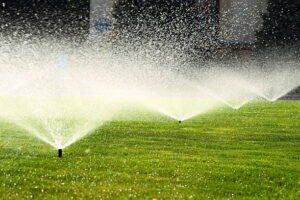[et_pb_section fb_built=”1″ _builder_version=”4.16″ custom_padding=”6px|0px|6px|0px|false|false” global_colors_info=”{}”][et_pb_row _builder_version=”4.16″ background_size=”initial” background_position=”top_left” background_repeat=”repeat” custom_padding=”0px|0px|13px|0|false|false” global_colors_info=”{}”][et_pb_column type=”4_4″ _builder_version=”4.16″ custom_padding=”|||” global_colors_info=”{}” custom_padding__hover=”|||”][et_pb_text _builder_version=”4.17.4″ background_size=”initial” background_position=”top_left” background_repeat=”repeat” hover_enabled=”0″ inline_fonts=”Verdana,Montserrat” global_colors_info=”{}” sticky_enabled=”0″]
Every commercial property owner wants a lush turf that welcomes their visitors but keeping up with the demands to maintain the ascetic can be challenging. Does watering a commercial property seem daunting with all the variables that impact how often, how much and when you should water.
Different grass types need more water than other turfs. The shady areas of your property won’t need the same amount of water as the sunny side. The time of the year and your region’s weather patterns will impact how much water is required.
You must uncover the right balance to achieve that beautiful, lush turf. If you don’t find that balance, you can either over water, which will kill the grass, or not provide sufficient water, which still kills the grass. To assist in reaching your goal of a lush landscape, we have listed some water-efficient tips.
Smart Irrigation System
Have a professional landscaping company inspect your irrigation system to ensure it is in proper working order. They should perform a “wet check.” A wet check includes checking nozzles to ensure they’re not clogged or damaged and confirm all areas of your landscape are receiving water and not pointing away from the grass or plants.
Older irrigation systems should be retrofitted with moisture sensors and other “smart” features to regulate the system’s water flow properly.
Irrigation can become costly if you have an outdated system because it will waste water. The investment of updating your system will pay for itself in the long run from the energy and water savings.
Best Times to Water
For most commercial landscapes, the early morning is the best time to water but you should also water later in the afternoon. You want the grass to have water prior to the sun reaching its highest temperatures to ensure more water reaches the roots. You need to water once again later in the afternoon when the sun is no longer at its highest peak. Each watering session should be eight minutes long to allow the grass to fully absorb the water which will stop any runoff as it will if you only watered once a day at a longer time period.
Water Efficient Plants
Choosing the right plants will play a significant role in water consumption. All plants are not created equal; some require more water than others. Therefore, choosing the right plants can significantly affect how much water your commercial landscape needs. The best defense in the fight to lower water costs is selecting native plants that naturally adapt to your regional weather conditions.
The right plants are essential, but equally important is the correct location on your property to plant them. Use the assistance of a professional for the proper advice and guidance on your options.
If you need additional assistance with reducing your watering costs on your commercial property but don’t want to lose the appeal of your landscape, contact a commercial landscaper to guarantee success. If your landscaper is not performing these tasks, it is time to switch.
Our team of professionals at JBa Land Management is available to service all-size commercial properties in the Dallas-Ft Worth Metroplex. Contact us at (214) 660-1500 for a free quote on your property.
[/et_pb_text][/et_pb_column][/et_pb_row][/et_pb_section]


